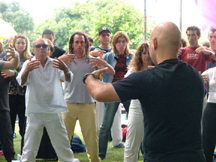This is an old revision of this page, as edited by Labco1 (talk | contribs) at 00:28, 7 March 2013 (→External links). The present address (URL) is a permanent link to this revision, which may differ significantly from the current revision.
Revision as of 00:28, 7 March 2013 by Labco1 (talk | contribs) (→External links)(diff) ← Previous revision | Latest revision (diff) | Newer revision → (diff)| This article includes a list of references, related reading, or external links, but its sources remain unclear because it lacks inline citations. Please help improve this article by introducing more precise citations. (August 2009) (Learn how and when to remove this message) |
| The examples and perspective in this article may not include all significant viewpoints. Please improve the article or discuss the issue. (August 2009) (Learn how and when to remove this message) |
| Zhan zhuang | |||||||
|---|---|---|---|---|---|---|---|
 Zhan zhuang training on the Zhan zhuang training on theWorld Tai Chi and Qigong Day, Israel. | |||||||
| Chinese | 站桩 | ||||||
| |||||||
Zhan zhuang, lit. 'standing like a post', is a qigong training routine often practiced by students of neijia (internal kung fu), such as t'ai chi ch'uan. Zhan zhuang is sometimes translated as standing-on-stake, standing qigong, standing like a tree, post-standing, pile-standing.
Contrary to the most common notion of cardiovascular exercise necessitating vigorous movement, it is said that zhan zhuang confers significant physical conditioning. Postures used vary among martial arts and styles, with many schools using postures according to their own traditional forms (though the basic structure and principles of zhan zhuang practice largely do not vary).
Those unfamiliar with zhan zhuang can experience severe muscle fatigue and subsequent trembling at first. Later, once sufficient stamina and strength have been developed, the practitioner can use zhan zhuang to work on developing "zhong ding" or central equilibrium as well as sensitivity to specific areas of tension in the body. Some schools use the practice as a way of removing blockages in Qi flow. This blockage removal occurs because zhan zhuang, when correctly practised, causes a normalising effect on the body. Any habitual tension or tissue shortening (or lengthening) is normalised by the practice and the body regains its natural ability to function optimally. It is thought that a normalised body will be less prone to muscular skeletal medical conditions, and it is also thought that zhan zhuang, when practised for developing relaxed postures, will lead to a beneficial calming effect..
Possibly the most well-known example of zhan zhuang training is the "horse stance" or ma bu 馬步.
Many styles, especially the internal styles, combine post standing with qigong training and other coordinated body methods to develop whole body coordination for martial purposes. The martial practice is thought to strengthen the body's Central Nervous System and develop the coordination required for effective martial performance .
Yiquan is known for having discarded adherence to form as found in its parent art, Xingyiquan, in favour of what are claimed to be formless methods, including zhan zhuang. Most Yiquan teachers place emphasis on zhan zhuang as it is the best neigong exercise, and divide it into two distinct categories: jianshen zhuang (health stances) and jiji zhuang (combat stances).
See also
Books
- J.P.C. Moffett, Wang Xuanjie (1994), Traditional Chinese Therapeutic Exercises: Standing Pole.
- Lam Kam Chuen, Gaia Books Ltd, 2005 ISBN 1-85675-215-1, "Chi Kung: The Way of Energy".
- Peter den Dekker, Back2Base Publishing BV, 2010 ISBN/EAN: 978-94-90580-01-8, "The Dynamics of Standing Still"
External links
- PowerStanding
- Free Zhan Zhuang Lesson
- 10 day Zhan Zhuang training course
- Ki/Chi Society
- Zhan Zhuang explanations - Website of The French Academy of Kung Fu Yi Quan(FR)
- Michael P. Garofalo's Zhan Zhuang internet/bibliographic reference for practitioners
- Yiquan Zhan zhuang
- neigong.net - a simple reference
- Do You Make This Zhan Zhuang Mistake?
- Zhan Zhuang - foundation of Internal Martial Arts
- Body Posture for Qigong
- How To Do Zhan Zhuang for Beginners
- Zhan Zhuang Adjustments
| Qigong | ||
|---|---|---|
| Main topics |  | |
| TCM and philosophy | ||
| Traditional practices | ||
| Qigong forms and styles | ||
| Qigong masters |
| |
| Spiritual movements and politics | ||
| Related topics | ||
| Chinese martial arts | |
|---|---|
| Practical grappling | |
| Practical striking | |
| Styles | |
| Techniques | |
| Wushu (sport) | |